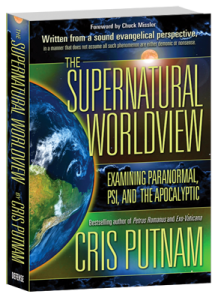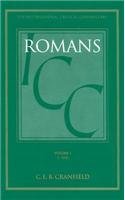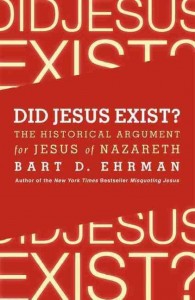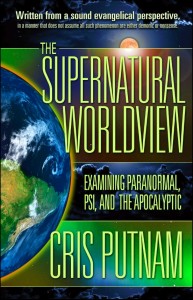 My new book The Supernatural Worldview to be released in May has a website http://www.supernaturalworldview.com/. I will be posting excerpts from the book as well as blogging on subjects and news articles relevant to the topics in the book. The book focuses on worldview apologetics for what I call the paranormal paradigm shift, an idea I explained here. Within you will find unconventional apologetics for the Christian faith by the way of defeaters for naturalism. These include: 1) the evidence for extrasensory perception, also called psi—a controversial area for Christian apologetics; 2) the near-death experience, which implies that consciousness survives bodily death; and 3) the evidence for spirits and apparitions, whether of human or nonhuman origin. While any one of these serves as a defeater for naturalism, the biblical worldview can account for all of the above.
My new book The Supernatural Worldview to be released in May has a website http://www.supernaturalworldview.com/. I will be posting excerpts from the book as well as blogging on subjects and news articles relevant to the topics in the book. The book focuses on worldview apologetics for what I call the paranormal paradigm shift, an idea I explained here. Within you will find unconventional apologetics for the Christian faith by the way of defeaters for naturalism. These include: 1) the evidence for extrasensory perception, also called psi—a controversial area for Christian apologetics; 2) the near-death experience, which implies that consciousness survives bodily death; and 3) the evidence for spirits and apparitions, whether of human or nonhuman origin. While any one of these serves as a defeater for naturalism, the biblical worldview can account for all of the above.
New Supernatural Worldview Website
C.E.B. Cranfield on the Inconsistency of Replacement Theology
by Cris Putnam
C.E.B. Cranfield is a renowned New Testament scholar and author of several commentaries, including Romans in the prestigious International Critical Commentary series. He is a Cambridge educated emeritus professor of theology at University of Durham in England. He is reformed in his theology. His commentary on Romans is considered one of the very best by scholars of all stripes. From careful exegesis of Romans 9-11 he confidently casts supercessionism (replacement theology) as an unfortunate twisting of Pauline theology. One comment in particular should put a stone in the shoe of the replacement theologian:
It is only where the Church persists in refusing to learn this message, where it secretly—perhaps quite unconsciously! —believes that its own existence is based on human achievement, and so fails to understand God’s mercy to itself, that it is unable to believe in God’s mercy for still unbelieving Israel, and so entertains the ugly and unscriptural notion that God has cast off His people Israel and simply replaced it by the Christian Church. These three chapters [Romans 9-11] emphatically forbid us to speak of the Church as having once and for all taken the place of the Jewish people.[1]
Cranfield is most certainly correct. I really do not know how Paul could have spelled it out any clearer than this: “As regards the gospel, they are enemies for your sake. But as regards election, they are beloved for the sake of their forefathers. For the gifts and the calling of God are irrevocable.”(Romans 11:28–29)
[1]C. E. B. Cranfield, A Critical and Exegetical Commentary on the Epistle to the Romans (London; New York: T&T Clark International, 2004), 448.
Review Did Jesus Exist by Bart Ehrman
by Cris Putnam
 I just finished Bart Ehrman’s response to the Jesus mythicists Did Jesus Exist? The Historical Argument for Jesus of Nazareth. A “Jesus mythicist” is a person who believes that Jesus never existed as a man but was a literary creation of biblical authors. Part I of the book presents the overwhelming evidence that Jesus did exist: Chapter 2: Non-Christian Sources for the Life of Jesus, Chapter 3: The Gospels as Historical Sources, Chapter 4: Evidence for Jesus from Outside the Gospels, and Chapter 5: Two Key Data for the Historicity of Jesus. Based on this wealth of evidence, Ehrman argues convincingly that, contrary to claims of a few radical mythicsts, virtually all scholars of antiquity agree that: “Jesus was a Jewish man, known to be a preacher and teacher, who was crucified (a Roman form of execution) in Jerusalem during the reign of the Roman emperor Tiberius, when Pontius Pilate was the governor of Judea.”[1] Mythicism is truly a position on the fringe of scholarship.
I just finished Bart Ehrman’s response to the Jesus mythicists Did Jesus Exist? The Historical Argument for Jesus of Nazareth. A “Jesus mythicist” is a person who believes that Jesus never existed as a man but was a literary creation of biblical authors. Part I of the book presents the overwhelming evidence that Jesus did exist: Chapter 2: Non-Christian Sources for the Life of Jesus, Chapter 3: The Gospels as Historical Sources, Chapter 4: Evidence for Jesus from Outside the Gospels, and Chapter 5: Two Key Data for the Historicity of Jesus. Based on this wealth of evidence, Ehrman argues convincingly that, contrary to claims of a few radical mythicsts, virtually all scholars of antiquity agree that: “Jesus was a Jewish man, known to be a preacher and teacher, who was crucified (a Roman form of execution) in Jerusalem during the reign of the Roman emperor Tiberius, when Pontius Pilate was the governor of Judea.”[1] Mythicism is truly a position on the fringe of scholarship.
In fact, mythicism itself did not exist until relatively recently. It’s not much of a surprise that none of Christianity’s earliest critics ever claimed Jesus did not exist. The first biblical scholar to make such a radical claim was Bruno Bauer who thought that Christianity was a combination of Judaism with the Roman philosophy of Stoicism.[2] He wasn’t taken seriously and his views were quickly discredited. A German scholar, Arthur Drews, wrote The Christ Myth (1909) which Ehrman believes was “the most influential mythicist book ever produced”[3] because it had a widespread effect across the Soviet Union in servicing Lenin and Stalin’s campaign to stamp out the church. Most thoroughly addressed are Earl Doherty, a layman, and Robert Price, a rare breed of mythicist biblical scholar, and Richard Carrier who holds a Ph.D. in classics from Columbia University. Ehrman exposes the likes of Archarya S. (DM Murdock), the primary source for the debunked Zeitgeist film, as pseudo-scholars who have failed to do proper research in the original source documents and Ehrman embarrasses them badly. He writes:
Just to give a sense of the level of scholarship in this sensationalist tome [The Christ Conspiracy: The Greatest Story Ever Sold], I list a few of the howlers one encounters en route, in the order in which I found them. Acharya claims that:
-
The second-century church father Justin never quotes or mentions any of the Gospels.. [This simply isn’t true: he mentions the Gospels on numerous occasions; typically he calls them “Memoirs of the Apostles” and quotes from them, especially from Matthew, Mark, and Luke.]
-
The Gospels were forged hundreds of years after the events they narrate. [In fact, the Gospels were written at the end of the first century, about thirty-five to sixty-five years after Jesus’s death, and we have physical proof: one fragment of a Gospel manuscript dates to the early second century. How could it have been forged centuries after that?]
-
We have no manuscript of the New Testament that dates prior to the fourth century. [This is just plain wrong: we have numerous fragmentary manuscripts that date from the second and third centuries.]
-
The autographs “were destroyed after the Council of Nicaea”. [In point of fact, we have no knowledge of what happened to the original copies of the New Testament; they were probably simply used so much they wore out. There is not a scintilla of evidence to suggest that they survived until Nicaea or that they were destroyed afterward; plenty of counterevidence indicates they did not survive until Nicaea.]
-
“It took well over a thousand years to canonize the New Testament,” and “many councils” were needed to differentiate the inspired from the spurious books. [Actually, the first author to list our canon of the New Testament was the church father Athanasius in the year 367; the comment about “many councils” is simply made up.][4]
I have to admit I thoroughly enjoyed this part of the book. He lists many more, showing why “mythicists as a group, and as individuals, are not taken seriously by the vast majority of scholars in the fields of New Testament, early Christianity, ancient history, and theology.”[5]
While the shredding of Archarya S. makes for great sport, it is important to keep in mind that Ehrman is no friend to evangelical Christianity. He has built a career on his deconversion testimony from inerrancy affirming fundamentalist to freethinking skeptical agnostic. His book titles like Misquoting Jesus, Jesus Interrupted, God’s Problem, and Forged reveal his anti-evangelical zeal. Even so, when someone hostile to one’s position argues a position that favors it, it seems more compelling. If one overlooks his bias, Did Jesus Exist? Is a valuable resource for evidencing the historical Jesus.
While I enjoyed the book, I took issue with many of Ehrman’s claims. In particular, I would like to address his handling of Daniel’s Seventy Weeks prophecy (Dn 9:24-27) and then offer a minimal facts argument based on that prophecy. This prophecy comes up in Did Jesus Exist? because mythicist Richard Carrier uses it to demonstrate that some Jews were expecting the messiah to suffer and die (a fact Ehrman disputes). He argues:
Carrier tries to establish his point about the humiliated messiah first by quoting Isaiah 53. But as I’ve shown, Isaiah is not speaking about the future messiah, and he was never interpreted by any Jews prior to the first century as referring to the messiah. Carrier’s argument becomes more interesting when he appeals to a passage in chapter 9 of the book of Daniel. This is one of those postdated prophecies so common to the final six chapters of Daniel. By postdated prophecies I mean this: the book of Daniel claims to be written by a Hebrew man, Daniel, in the Babylonian exile, around 550 BCE. In actual fact, as critical scholars have long known (Carrier agrees with this), it was written closer to 160 BCE.14 When the character Daniel in the book “predicts” what is going to happen, the real author, pretending to be Daniel, simply indicates what already did happen. And so it sounds as if the sixth-century prophet knows the future because what he predicted in fact came to pass.[6]
Actually, it is far from established that Daniel was written in 160 BC and there are compelling arguments that it was written in the sixth century (~ 540 BC) as it internally claims. Please refer to this essay by Bruce Waltke at Knox Theology Seminary. The late dating of the book is more of a worldview issue than a historical one. This is because Daniel’s prophecies are so accurate that skeptics are forced to date the writing after the predicted events or accept supernatural revelation (something they dare not do). Ehrman attempts to do just that with Daniel’s seventy weeks prophecy that the messiah would be “cut off” prior to the destruction of Jerusalem (Dn 9:26) but in so doing, he completely ignores facts contrary to his interpretation. Ehrman presents Carrier’s position in order to argue against it:
Daniel 9 is a complicated passage that “predicts” in precise detail what will happen to the people of Jerusalem over the course of “seventy weeks” that have been “decreed for your people and your holy city; to finish the transgression, to put an end to sin, and to atone for iniquity.” The weeks are interpreted within the text itself to mean seventy “weeks of years”—that is, one week represents seven years. According to verse 25 there will be seven such weeks of years separating the order to rebuild destroyed Jerusalem and the appearance of “an anointed prince.” Verse 26 then indicates that sixty-two weeks of years later an “anointed one” shall be “cut off and shall have nothing.” Carrier argues strenuously that this shows that the author of Daniel expected that the messiah (the “anointed one”) had to be killed (“cut off”).[7]
He then responds, “It is an interesting interpretation but highly idiosyncratic. You won’t find it in commentaries on Daniel written by critical Hebrew Bible scholars (those who are not fundamentalists or conservative evangelicals), and for some good reasons.”[8] He disputes that the prophecy is messianic by arguing it simply refers to an “anointed one.” However, Māšîaḥ nāgîd in Hebrew is a king (or prince) and a priest and this hardly applies to Joshua or Onias III as Ehrman asserts. In fact, the Old Testament law separates the duties of priest and king. Of course, he commits the genetic fallacy by excluding conservatives a priori and completely ignoring their arguments. But he commits a more egregious fallacy of Suppressed Evidence by not addressing central feature of the prophecy, the seventy weeks of years.
The Maccabean view of Daniel espoused by Ehrman does not add up. Liberals attempt to start the seventy weeks at 586 B.C. destruction of Jerusalem but his seems to be a pure contrivance to make the math appear to work… well, sort of. However, there was no decree to rebuild the temple as the prophecy specifies (Dn 9). Even granting the starting point of 586 B.C. yields an end at 96 B.C. long after Antiochus’ persecution and the restoration of the temple. The inconvenient fact that Ehrman and other liberal scholars ignore is the specified time period of seventy weeks of years excludes the Maccabean period and affirms the prophecy’s culmination at Jesus’ crucifixion. In my book The Supernatural Worldview I present a minimal facts argument for the supernatural inspiration of the Bible based on this prophecy:
While there are several interpretations of this prophecy held by sincere, Bible-believing scholars, nearly all evangelicals and even some Jewish scholars agree it is messianic. In fact, this prophecy alone has led many Jews to accept Yeshua (Jesus) as their Messiah. Because my purpose here is to merely demonstrate that the future was written in advance, I present a minimal-facts case from five key points:
- First, the prophecy was unquestionably written down before Jesus was born. Conservative scholars like Dr. Bruce Waltke at Knox Theological Seminary argue vigorously for dating the book to sixth century BC as it internally claims.[9] However, even the most liberal scholars late date it to the second century BC during the Maccabean period (over three hundred years later than the book claims). A total of eight fragmentary copies of the book of Daniel were found at Qumran amongst the Dead Sea Scrolls (DSS), but none is complete due to the effects of extreme age. However, between them, they preserve text from eleven of Daniel’s twelve chapters (chapter 12 is missing but quoted in another DSS work). The discovery labeled 4QDane (4Q116) contains part of chapter 9. All eight manuscripts were copied within 175 years, ranging from 125 BCE (4QDan) to about AD 50 (4QDan). The mere fact that it was accepted as canonical at Qumran means it was necessarily composed long before the oldest date in the second century.
- Second, any coherent reading must account for the elements in verse 24: 1) Finish the transgression; 2) Make an end of sins; 3) Make reconciliation for iniquity; 4) To bring in everlasting righteousness; 5) To seal up the vision and prophecy; and 6) To anoint the Most Holy.
- Third, there is scholarly debate on whether the “commandment to rebuild” is the decree to Ezra in 458 BC (Ezra 7:11–26), Sir Robert Anderson’s date of 445 BC widely popularized in his book, The Coming Prince,[10] or 444 BC, as purposed by Waltke and others.[11] Because I am making a minimal-facts case, the exact date isn’t important. No one disputes that there was a command to rebuild between 458 and 444 BC.
- Fourth, the prophecy predicts the Messiah will be cut off after sixty-nine weeks of years (483 years). Some object to the translation of mashiach as “the Messiah,” because the Hebrew can also mean “anointed one” and also because the definite article “the” is not in the original text. However, the oldest Jewish translation, the Septuagint, translates mashiach as tou christou (“the anointed one”), which is where the word “Christ” derives. Furthermore, mashiach nagid is a priest and a king (or prince), but the Old Testament law separated those duties for Israelites and predicts that they are to be uniquely combined in the Messiah (Isaiah 9:6–7). For this reason, many rabbis hesitantly acknowledge the seventy-weeks prophecy as Messianic.[12]
- Fifth, after the Messiah is “cut off,” the city and sanctuary will be destroyed. That Jesus was crucified between AD 30–AD 33 is virtually uncontested. Even secular Roman historians like Tacitus wrote about His crucifixion.[13] It is also an undisputed historical fact that the Roman army led by Titus Vespasian destroyed Jerusalem and the temple in AD 70.[14]
Based on these well-established facts, one must ask if there is another viable candidate for the Jewish Messiah who was “cut off” just prior to the destruction of Jerusalem in AD 70.[15]
Did Jesus Exist? is valuable addition to my library as a hostile witness to the historical Jesus and presents an devastating refutation of the Jesus-mythicist absurdity.
[1] Bart Ehrman, Did Jesus Exist?: The Historical Argument for Jesus of Nazareth, Kindle Edition,(HarperCollins, 2012), 12.
[2] Ehrman, Did Jesus Exist?,16.
[3] Ehrman, Did Jesus Exist?, 17.
[4] Ehrman, Did Jesus Exist?, 23-24.
[5] Ehrman, Did Jesus Exist?, 20.
[6] Ehrman, Did Jesus Exist?, 67-168.
[7] Ehrman, Did Jesus Exist?, 168.
[8] Ehrman, Did Jesus Exist?, 168.
[9] Bruce K. Waltke, “The Date of the Book of Daniel,” Bibliotheca Sacra, 133:532, (October 1976): 329. Journal article available here: https://www.galaxie.com/article/bsac133-532-04.
[10]Sir Robert Anderson, The Coming Prince, 59. Note: This book is widely available for download online; print versions available at www.amazon.com and other online booksellers.
[11] Waltke, 329.
[12]]Michael L. Brown, Answering Jewish Objections to Jesus: Messianic Prophecy Objections, vol. 3 (Grand Rapids, MI: Baker, 2003) 89.
[13] The Roman historian and Senator Tacitus referred to Jesus Christ, His execution by Pontius Pilate, and the existence of early Christians in Rome in his final work, Annals (written ca. AD 116), book 15, chapter 44.
[14] Flavius Josephus, book 7, chapter 1.1, The Wars of the Jews or History of the Destruction of Jerusalem.
[15] Cris Putnam, The Supernatural Worldview, (Crane, MO, Defender, 2014), 53-54.
Only Two Religions — Oneism or Twoism — Where do you stand?
The work of Dr. Peter Jones at truthXchange has become highly influential on the conclusions of my current book project The Supernatural Worldview. According to Jones Romans 1:25 allows for only two religions based on the creator/creation distinction or lack their of. In this way two options emerge oneism (all is one, pantheistic monism) and twoism (theism including a transcendent Creator). This simplifies a great deal and makes a great starting point in worldview analysis. The video below is a brief introduction to the concept.
Christmas Trees Are Not Pagan!
By Cris Putnam
Christmas is certainly not pagan. Sure, Jesus’ birth was probably in the Fall rather than December but the exact day is uncertain. Even so, Christmas is the celebration of the savior’s birth because that is when most all Christian churches celebrate. While some customs have a distant pagan origin, the idea that Christmas trees are pagan is almost certainly false. Jeremiah 10 describes fashioning Canaanite idols from fresh cut wood and precious metals. It has nothing to do with Christmas trees. There have been a myriad of customs in different cultures using holly and evergreen but there is not a discernable evolution from paganism to today’s Christmas tree from the ancient world. Christianity relegated pagan belief to the cultural dustbin and tree customs were sporadic and divergent until after the reformation. The modern tree began in sixteenth century Germany. The best evidence points to Martin Luther for popularizing the candle lit evergreen tree.[i] As the reformation spread, so did Luther’s legacy. A popular artist, Carl Schwerdgeburth, painted a scene of Luther’s family around a candle-lit tree:
Painting source[ii]
This painting, depicting what oral tradition indicated happened in 1536, was engraved in a gift book titled Wheat Sheaf from 1853 that was published in Philadelphia. It also said that Luther was the first to light a tree with candles in order to illustrate the “light of God” to his children.
Because Luther was a great advocate of Christmas, the Christmas tree became a sign of Protestant solidarity and German nationalism. The Catholic majority of the lower Rhine discouraged the lighted tree as a Protestant custom. In the early nineteenth century, lit trees gained widespread acceptance across Germany.[iii] Most likely, the tradition came to the United States with Hessian troops during the American Revolution and/or the German immigrants to Pennsylvania and Ohio.
Many have pointed out the New England puritans did not recognize the holiday. However, their reasoning for disdain was not its alleged pagan origins but rather a form of strict biblicism that asserted that if a holiday is not in scripture it should not be celebrated. Not many folks still agree that conclusion is scriptural because it is inconsistent with our freedom of conscience in Christ (Col 2:16). Because we are not under Israelite ceremonial law, we are free to celebrate the birth of the savior any day we please! Finally, it is safe to say, that hardly anyone is thinking about pagan deities while performing Christmas traditions. Most of the conspiracy theories give paganism too much credit. Paganism did not infect Christianity but rather Christianity made paganism irrelevant.
[i] Karal Ann Marling, Merry Christmas! Celebrating America’s Greatest Holiday,( Boston: Harvard University Press, 2009), 176.
[iii]Johannes Marbach, The Holy Christmas season for meaning, history, customs and symbols (Stutgart: 1859), 416. http://books.google.com/books?id=FXhEAAAAcAAJ&pg=PA416#v=onepage&q&f=false




